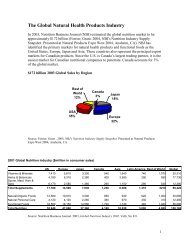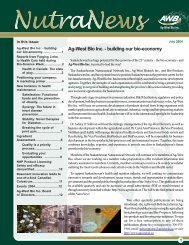Beyond Borders: Global biotechnology report 2010
Beyond Borders: Global biotechnology report 2010
Beyond Borders: Global biotechnology report 2010
Create successful ePaper yourself
Turn your PDF publications into a flip-book with our unique Google optimized e-Paper software.
Financing<br />
A higher bar<br />
After a dismal performance in 2008,<br />
biotech funding levels rebounded nicely<br />
in 2009. In the US, Europe and Canada,<br />
biotech companies raised US$23.2 billion,<br />
a 42% increase relative to 2008. While<br />
this was about 20% lower than the levels<br />
achieved in the “easy money” era of<br />
2006 and 2007, it is certainly impressive<br />
in today’s more challenging financing<br />
environment. But the real story — a tale of<br />
“haves” that raised large sums and “havenots”<br />
that must cross higher hurdles to<br />
attain funding — lies in the details behind<br />
the totals.<br />
While venture capital totals largely held<br />
steady in 2009 (as they had in 2008, even<br />
amid the worst of the financial crisis), the<br />
stories in the US and Europe could hardly<br />
have been more different: the US had<br />
its second-best venture funding year in<br />
the decade, while Europe had its worst.<br />
Across all geographies, new companies<br />
seeking venture capital faced a higher bar<br />
from investors.<br />
On the other end of the spectrum, there<br />
was plenty of capital available for<br />
established public companies. Follow-on<br />
funding from the public equity markets<br />
increased more than 250% to US$6.6<br />
billion — the second-highest total of the<br />
decade. In Europe, follow-on funding<br />
reached the highest level of the decade.<br />
However, a few “haves” dominated the<br />
picture, with a handful of very large<br />
transactions accounting for the majority of<br />
capital raised.<br />
For companies looking to raise public<br />
equity for the first time, the picture<br />
remained somewhat murky. While a few<br />
companies successfully tested the waters<br />
in 2009, many others remain cautiously<br />
hopeful and are waiting in the IPO queue.<br />
The aftermarket performance of IPOs<br />
remains mixed, however, which is a barrier<br />
to more widespread investor enthusiasm<br />
for new issues.<br />
Recovery and the new normal<br />
In last year’s <strong>Beyond</strong> borders, we<br />
discussed in some detail the impact that<br />
the global financial crisis was having on the<br />
<strong>biotechnology</strong> industry. As the biotech industry<br />
was swept up in the tsunami that struck the<br />
financial markets, many investors — both<br />
individual and institutional — sought the<br />
safety of higher ground in investments that<br />
were perceived to be safe. Others were<br />
forced to liquidate because of margin calls<br />
Capital raised in the US, Europe and Canada, 2000–09 (US$m)<br />
64 <strong>Beyond</strong> borders <strong>Global</strong> <strong>biotechnology</strong> <strong>report</strong> <strong>2010</strong><br />
as market capitalizations declined in all<br />
sectors. As a result, small- and mid-cap<br />
biotech companies in particular saw their<br />
values decline and their access to capital<br />
diminish, in many cases without regard to<br />
their underlying fundamentals.<br />
Companies took aggressive action to<br />
reduce their burn rates and to cast a wide<br />
net for financing to stay afloat. In early<br />
2009, the conversation turned to industry<br />
consolidation and speculation about how<br />
the ranks of companies would shrink over<br />
the coming year, either because they were<br />
swallowed by acquirers or because they had<br />
to cease operations.<br />
As it turns out, despite a significant number<br />
of company closings, the industry has been<br />
more resilient than many expected. The<br />
year started slowly on the fund-raising<br />
front, with mature, profitable companies<br />
accounting for the majority of funds raised<br />
early in the year. By spring, however,<br />
there were clear signs of renewed market<br />
interest in the industry, catalyzed by several<br />
upside clinical surprises in the US, including<br />
Dendreon’s April release of positive clinical<br />
data for its prostate cancer treatment,<br />
Provenge. By the end of June, the market<br />
caps of small- and mid-cap stocks had<br />
increased by 8% and 12%, respectively.<br />
2009 2008 2007 2006 2005 2004 2003 2002 2001 2000<br />
IPOs 823 116 2,253 1,872 1,785 2,429 484 602 438 7,312<br />
Follow-ons 6,579 1,840 3,345 6,303 4,600 3,380 4,046 1,070 2,431 15,832<br />
Other 10,044 8,244 16,928 14,930 8,442 11,732 10,174 5,546 4,471 11,676<br />
Venture 5,765 6,131 7,407 5,448 5,425 5,677 4,184 3,578 4,268 5,093<br />
Total 23,211 16,332 29,932 28,553 20,252 23,218 18,889 10,795 11,609 39,913<br />
Source: Ernst & Young, BioCentury, BioWorld and VentureSource<br />
Numbers may appear inconsistent because of rounding.








